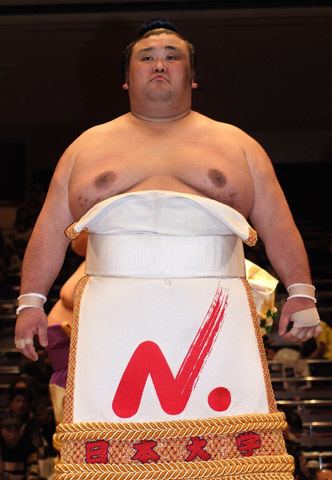Name Kiyoseumi Takayuki Weight 178 kg Retired April 2011 Height 1.83 m | Debut January, 2007 Makuuchi rank Maegashira Record 157-129-33 Role Sumo wrestler Career start January 2007 | |
 | ||
Highest rank Maegashira 13 (March, 2008) Stables Yamahibiki stable (2010–2011), Kise stable (2006–2010) Similar People Toyozakura Toshiaki, Yamamotoyama Ryuta, Shotenro Taishi, Asofuji Seiya, Kasugao Katsumasa | ||
Kiyoseumi Takayuki (born 16 August 1984 as Takayuki Ichihara) is a former sumo wrestler from Nagoya, Japan. An extremely successful amateur, his highest rank in the professional sport was maegashira 13. He was forced to retire in April 2011 after an investigation by the Japan Sumo Association found him guilty of match-fixing.
Contents
Career
Initially competing under his real surname of Ichihara, he was an amateur sumo champion at Nihon University, where he won eleven national titles. He won the Japan Games and the National Amateur Championships and was runner-up in the Japanese university championship. He was crowned the "Amateur Yokozuna" of 2006. He joined Kise stable, run by another former Nihon University champion, the ex-maegashira Higonoumi. Because of his amateur achievements, Ichihara was able to make his professional debut at the rank of Makushita 10, the first makushita tsukedashi entrant to begin as high as the tenth rank.
After steady scores of five wins to two losses in his first two tournaments in January and March 2007, followed by 4-3 in May and July, he was promoted to the second jūryō division in November 2007 after a 6-1 at Makushita 1 East in September. He scored 13 wins to 2 losses, although he lost a playoff for the championship on the final day, and was immediately promoted to the top makuuchi division for January 2008. He was the first wrestler to make his makuuchi debut after spending only one tournament in jūryō since Daikiko in January 1991.
In his top division debut Ichihara won five of his first seven bouts but tired in the second week of the tournament, finishing with an 8-7 score. He injured his right knee on the opening day of the March 2008 tournament after losing to Homasho and had to withdraw. As a result, he was demoted all the way down to the rank of Jūryō 11 for the May tournament. He participated in the basho with his knee heavily strapped, and struggled to a make-koshi 7-8 score. In July he recovered from 0-5 down to post eight wins but withdrew on the final day after a recurrence of the injury.
He announced in December 2008 that he would be changing his shikona from his family name to Kiyoseumi for the January 2009 tournament. He produced a 9-6 score in his first tournament under his new name, but only a poor 4-11 in March. He managed a bare majority of wins in his next two tournaments, and remained near the bottom of the jūryō division for the rest of 2009.
He was suspended along with over a dozen other wrestlers from the July 2010 tournament after admitting involvement in illegal betting on baseball. As a result, he fell to the makushita division in September. After two 4-3 scores in makushita he returned to the juryo division in January 2011.
Retirement from sumo
In February 2011, it was revealed that text-messages discovered on confiscated mobile phones implicated Kiyoseumi in match-fixing, as they appeared to show him agreeing to throw bouts in exchange for money. Unlike Kasuganishiki (the wrestler with whom the texts were exchanged), Chiyohakuho and Enatsukasa who have admitted their involvement, Kiyoseumi has denied the allegations. However, the independent panel investigating the match-fixing claims has stated that it cannot deny his involvement based on the evidence. Of the 46 text messages discovered by the Metropolitan Police Department that mention match-fixing, 19 were either sent or received by Kiyoseumi. After an investigation by the Japan Sumo Association, he was one of 23 wrestlers found guilty of fixing the result of bouts and he was forced to retire in April 2011.
Following his retirement Ichihara opened a bar, Snack Ai, in Tokyo.
Fighting style
Kiyoseumi was an oshi-sumo specialist, preferring pushing and thrusting techniques (tsuki/oshi). His most common winning kimarite was hataki-komi, the slap down.
He was one of the largest wrestlers in sumo, at 180 kg or 400 lb. Being so large, he lacked speed and mobility, and there were concerns that his knee injury further hampered his movement and held him back.
